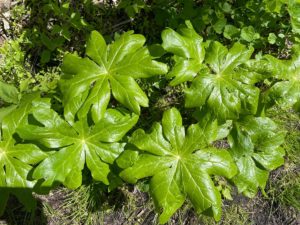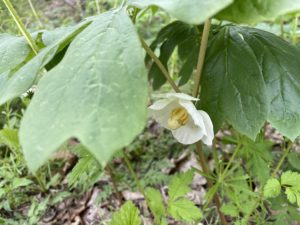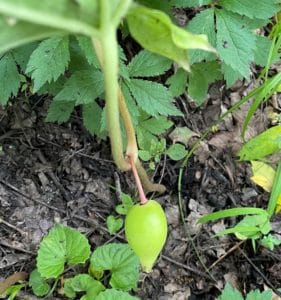Hello fellow readers, While walking along the Paulinskill Rail Trail the last few weeks, a low-lying plant that lines the sooty path in the shadier spots has caught my eye. Mayapple is a native perennial, a desirable one, unbeknownst to me while planting my first comprehensive perennial garden two decades ago. Now they are in bloom, although not noticeably as the flowers are hidden from view unless you look for them by leaning down or lifting the leaf.
 Why Mayapples are the apple of my eye:
Why Mayapples are the apple of my eye:
The charming plants look like a swath of glistening umbrellas or large shiny shamrocks—maybe why this ‘big kid’ adores them, imagining woodland fairies hiding below.
A poem shares the sentiment: “Down in the shady woodland where fern-fronds are uncurled, A host of green umbrellas are swiftly now unfurled. Do they shelter fairy people from sudden pelting showers? Or are the leaves but sunshades to shield the waxen flowers?” (Minnie Curtis Wait -1901).
Why is the common name Mayapple anyway? Maybe because they’re widely admired— “an apple of my eye.” The apple, the pupil, has become a metaphor for something precious.
An ideal background plant for a shady garden
My debut perennial garden was a shade garden, an endeavor that coincided with adopting my very first couple of pups, Sadie and Sara. I lived in Boonton Township, then along the Rockaway River. The swath of Mayapple took up much of the chosen garden spot. I should’ve kept it there to serve as a background plant had I known about the intriguing native plant.
Mayapple, Podophyllum peltatum, is a woodland perennial plant found along shady riverbanks, roadsides, and fields from northeastern North America to Texas in zones 3-8. And you can buy them from suppliers of native wildflower plants.
 They grow from shallow rhizomes, usually in thick colonies. Each upright branch rises twelve to eighteen inches from the ground, often with only one but sometimes two leaves with five to nine lobes that measure up to a foot across.
They grow from shallow rhizomes, usually in thick colonies. Each upright branch rises twelve to eighteen inches from the ground, often with only one but sometimes two leaves with five to nine lobes that measure up to a foot across.
If you yank them, as I sadly did, you’ll uncover the dark reddish-brown tubers below. So what do they say about regret? “Let’s not burden our remembrance with a heaviness that’s gone,” a saying Shakespeare made famous.
Magical Mayapple
Other than the berry, all parts of the Mayapple are poisonous, containing Podophyllotoxin, which is highly toxic if consumed in large quantities. Yet Native Americans used it as a cathartic to cleanse the bowel, amongst other things. Today it’s an ingredient in prescription drugs.
Curiously, only stems with two leaves will flower. And only one adorable white waxy flower with a dainty yellow center will develop hidden below the umbrella leaves. Then it turns into a lemon-shaped yellow fruit, though sometimes it’s pinkish or purplish, that ripens from August to September. They say the berry grows two inches long, though I’ve never come upon them, maybe because others have snagged them to make jam or jelly.
There’s a punchline about my first garden.
I had no idea that the natural spray I chose to fend off deer would also appeal to a couple of pups. Bobbex, at the time, smelled like a dead animal on which dogs love to roll to hide their scent from predators. It’s the wolf instinct, so they say. Maybe they’ve changed the formula since.
The deer didn’t devastate the new garden, but the pups rolling them flat sure did. But I have no regrets. “Mostly, you regret things you did not do (Proverb quote).” So I switched to a different spray—Deer-Out with a more pleasing clove-oil scent.
Garden Dilemmas? AskMaryStone@gmail.com (and your favorite Podcast App.)
In Episode 31 of the podcast, I share a story of a dear friend and fellow Karen Ann Quinlan Hospice Volunteer, Ken Roberts, who wrote a magical song titled Mandrakes, another name for Mayapple – link below.
You’ll enjoy Bruce Crawford of Rutgers Gardens’ talk titled Sexy Native Plants.
Link to a comprehensive list of Native Plants of North America



